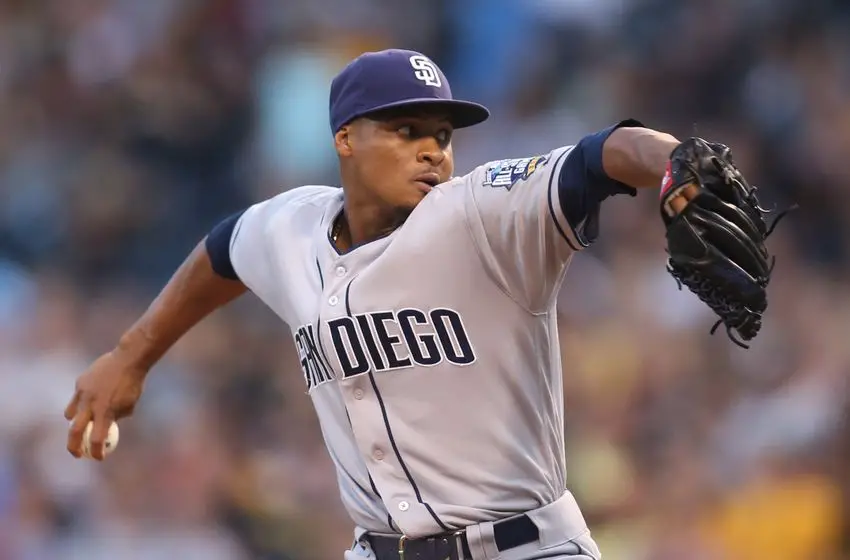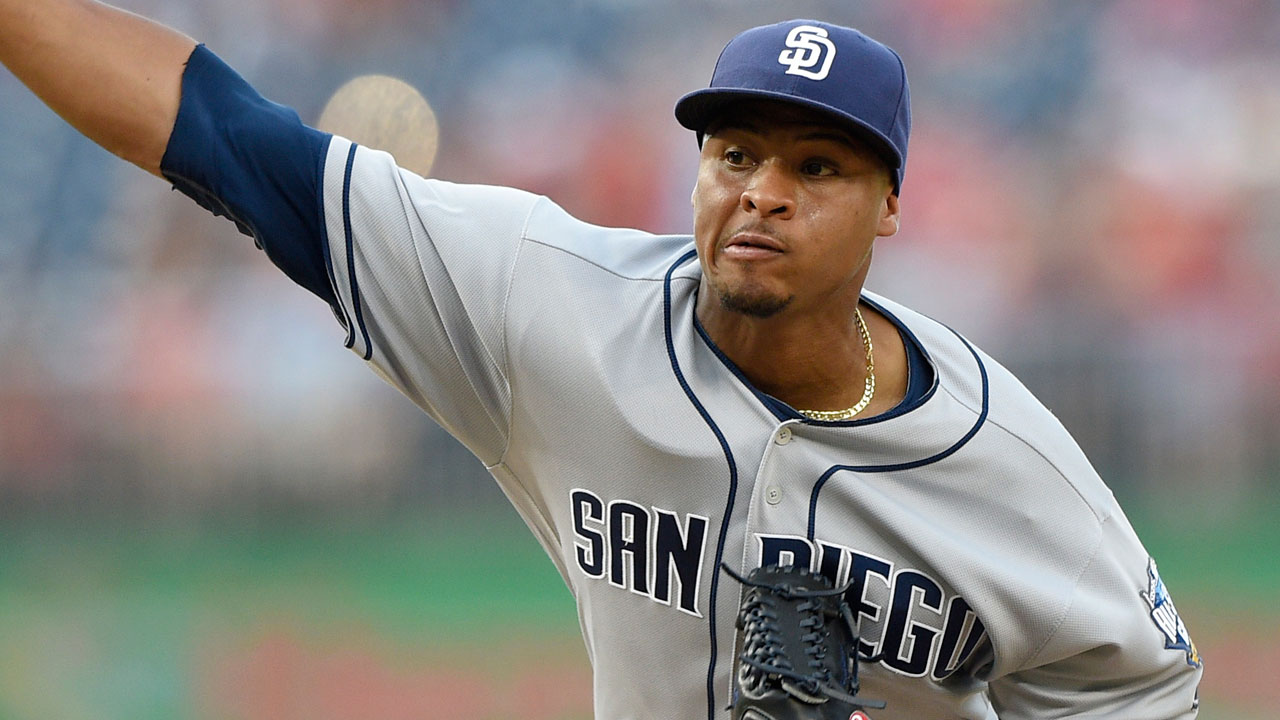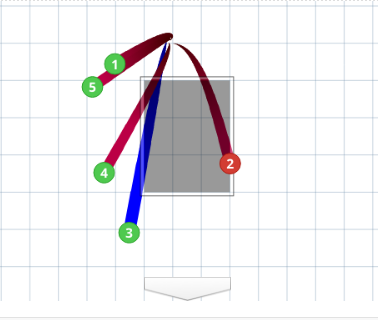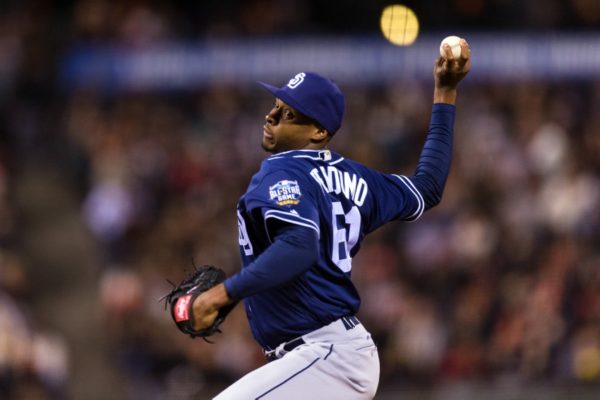Luis Perdomo’s Big Weakness

Mandatory Credit: Charles LeClaire-USA TODAY Sports

Believe it or not, the Major League Baseball season is almost halfway over. The San Diego Padres currently sit at 32-46, a full 19 games behind the first place Los Angeles Dodgers in the National League West, but still three and a half games ahead of the imploding San Francisco Giants. Going into the season, the Padres weren’t expected to be any good, and largely they haven’t been. However, they have exceeded expectations in some very key ways.
We all knew there would be plenty of talented young players to watch in hopes of seeing the Padres of the future bloom. From Manuel Margot to Austin Hedges to Hunter Renfroe and so on, there have been plenty of players worth watching develop. Although we expected these young guys to be worth watching, it is still great to see the positive development even with the struggles. We didn’t, however, expect the Padres to actually have a somewhat decent pitching staff at this late stage in the season.
Clayton Richard has been solid. Jhoulys Chacin had his share of ups and downs, but he has been lights out at Petco. Dinelson Lamet has been impressive in his first several starts. Prior to injury, Trevor Cahill was looking like a trade candidate this July. But above all of those guys, watching Luis Perdomo‘s development has been the biggest pitching staff storyline. We all expected Perdomo to develop further this season, but he has turned himself into a real big league pitcher.
However, even with all of his success and positive development this season, Perdomo has still had his share of struggles, as his 4.71 ERA and 4.35 FIP show. Sure, he’s still sporting one of the best ground ball rates in all of baseball, at 65.4 percent after last night’s start, but he is still learning and still making some critical mistakes. That fact was on full display last night in San Diego against the Atlanta Braves.
Luis Perdomo cruised through the first five innings for the Padres last night. He gave up a double in the first, a single in the third, a walk in the fourth, and a double in the fifth, but two key double plays and a few critical strikeouts kept him away from any trouble. Going into the top of the sixth, Perdomo was having one of his better starts of the season. However, Perdomo ran into some serious trouble in that sixth inning.
Going into the sixth inning, Perdomo had faced just 17 batters, meaning he had only gone through the batting order twice. Jace Peterson, batting for pitcher Bartolo Colon, led off the inning with a groundout. Then the leadoff hitter, Ender Inciarte, came up for his third at bat of the game, singling on a ground ball up the middle.
After Brandon Philips singled into right field, Nick Markakis came up to the plate with two runners on and one out, and worked a five pitch walk. At this point, Perdomo was noticeably laboring, as his pitches were missing well outside the zone to Markakis.

Former Padre great, just kidding, Matt Kemp, came to the plate with the bases loaded. Kemp worked himself into a hitter’s count at 2-1 and got a fastball right down the middle, which he grounded into center field, just past the dive of Erick Aybar for a two-run single. It was a mistake by Perdomo, and although the ball wasn’t hit very hard, it got the job done for the Braves.
Perdomo would give up another single to Matt Adams, once again loading the bases, still with only one out. At this point, Phil Maton would replace Perdomo in the game and proceeded to give up two more runs on a hit by pitch and an RBI groundout. So Perdomo’s final line ended up being five and one-third innings pitched with seven hits, four earned runs, two walks, and four strikeouts.
So what went wrong for Perdomo? Interestingly enough, it’s a similar thing that more often than not goes wrong for Perdomo. You can probably see where I am going with this, but as with most other major league pitchers, Luis Perdomo becomes a victim of the third time through the order penalty. For those who don’t know, this represents the decline in performance that a majority of pitchers experience as they face a batting order for the third time. However, Luis Perdomo experiences this problem more acutely than just about any other pitcher in the league.

Let’s take a look at Perdomo’s stats by times through the order. In 30.2 innings pitched facing the batting order for the first time, Perdomo sports a 3.29 ERA with a .259/.317/.362 slash line. That’s not great, but it’s solid for a guy in his developmental position. Moving forward, in 28.2 innings pitched facing the order for a second time, Perdomo has a still good 3.45 ERA with a .259/.365/.407 slash line against. So that second time through Perdomo is allowing more men to reach base and giving up more extra base hits, but he’s still doing a good job of limiting damage.
Now, let’s look at how Perdomo has fared the third time through the batting order. In 19 innings the third time through the order, Perdomo has an unsightly ERA of 9.00 with a .325/.381/.539 slash line against him. Perdomo’s HR/9 rate also jumps over a full run and his WHIP raises significantly alongside his BABIP. Taking it one step further, Perdomo’s soft hit rate falls about 10 percentage points from where it usually sits the first two times through the order. So on top of allowing more baserunners and more extra bases, Perdomo is simply being hit harder during that third time through the order. Interestingly enough, he’s maintaining similar ground ball and fly ball rates, but those balls are being hit slightly harder in the later innings of his starts, and more balls are being hit on the line than in earlier innings.
Now that we know the troubles Perdomo has going through lineups for the third time, we can ask ourselves how he can go about fixing these issues. The easiest solution would obviously be for Green to pull Perdomo before he gets to an order for the third time, but this would not only further strain an already worn out Padres bullpen, but would also not allow Perdomo to face the problem head on and figure it out.
The most obvious solution for Perdomo is to work further on varying his pitch usage. Although Perdomo technically threw four or five different pitches, he is almost exclusively a two-pitch pitcher. Given he throws his sinking fastball nearly 60 percent of the time, and his curveball just over 30 percent of the time, it’s pretty clear Perdomo needs to work on developing a more effective third pitch. He’s been mixing in a splitter more frequently in recent starts, but he needs to utilize a more effective third pitch in order to fool hitters in the later innings. Even despite this, Perdomo has still made great strides from where he was at on Opening Day 2016.
Editorial and Prospect Writer for East Village Times. Twenty-five years young, Patrick has lived in San Diego for his entire life and has been a Padres fan nearly as long. Patrick lives for baseball and is always looking to learn new things about the game he loves through advanced stats.